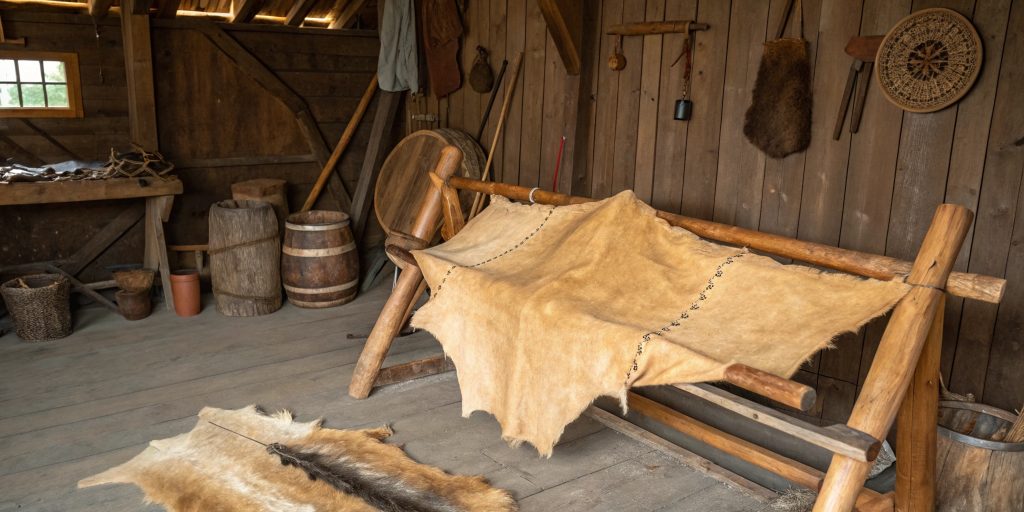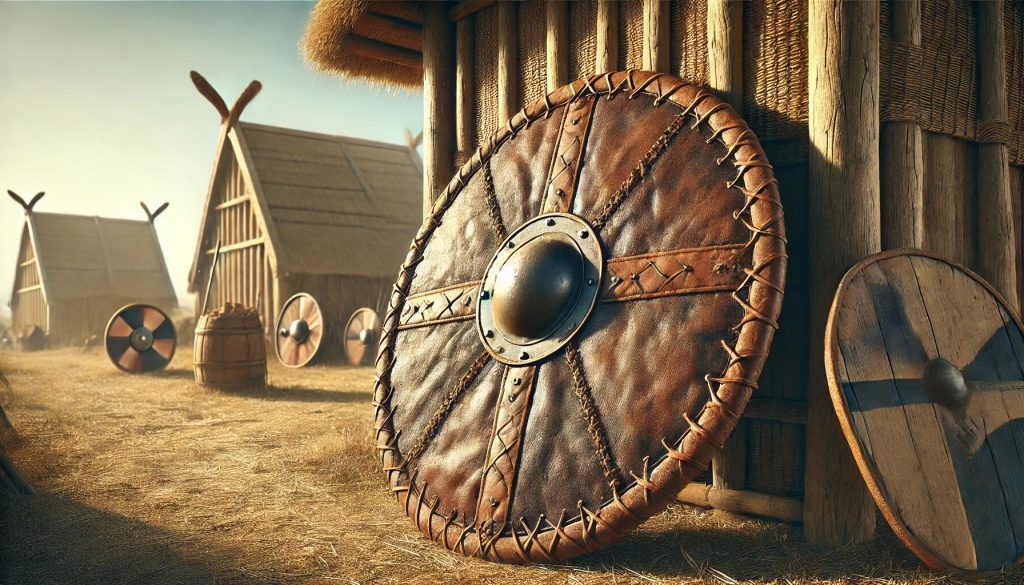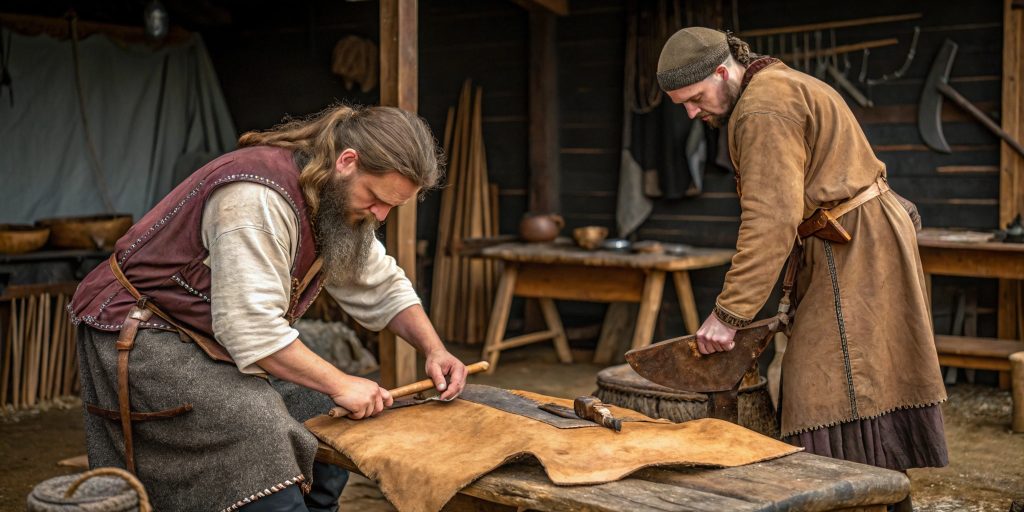Daily Life in the Viking Age, Vikings
How Did Vikings Tan Hides?
Viking hide tanning was vital for the Norse people. It turned raw animal skins into soft and strong leather. This skill was essential for Norse warriors, giving them clothes, armor, and tools.
This ancient art of crafting leather was more than useful; it was a vital part of Viking culture and made it richer. We will explore how Vikings tanned hides and their role in their lives and trade.
The Importance of Hide Tanning in Viking Culture
Hide tanning was key in Viking culture. It helped use every part of an animal, from meat to hide, in their daily lives. This made them efficient and sustainable, as they relied on nature for survival.
Turning animal skins into tanned hides was smart. It helped make important items for daily life.
Utilization of Animal Resources
Vikings were very clever with animal resources, utilizing supple leather for various crafts. They used skins for many things, not just food, including crafting protective gear and clothing. Bones became tools, and other parts were reused to avoid waste.
This showed their deep connection to nature. It also showed their skill in using natural materials.
The Role of Tanned Hides in Daily Life
Tanned hides were used in many ways in Viking life. They made clothes and armor, which kept people warm and safe.
Leather boots and cloaks were common. They showed Viking skill and usefulness. Hides were also used in armor, making Vikings safer in battle.
Hide tanning was more than useful; it was essential for those who depended on meat and clothing. It showed the Vikings’ adaptability and craftsmanship.
Understanding Viking Hide Tanning Techniques
Viking hide tanning showed their deep knowledge of materials and methods, particularly in crafting supple leather. They used natural agents to make leather, and their techniques showed their skill in creating solid and useful materials.
Traditional Methods of Tanning
Vikings often used vegetable tanning to ensure their garments would wear well over time. They also used tree bark tannins to make leather last long. They used alum to soften and keep the hides, making them more suitable for wear.

Materials Used in the Tanning Process
Vikings added special materials to their leather. They used:
- Clay for a smooth finish.
- Fatty substances for flexibility.
- Smoke from fires for unique looks.
These materials showed the depth of Viking craftsmanship, highlighting their skills in preserving the hide. They made leather that was both strong and flexible. Knowing these techniques helps us see their advanced skills and tanning’s role in their culture.
Viking Hide Tanning: A Step-by-Step Process
Viking hide tanning is a detailed and useful tradition passed down through generations of hunters. It starts with careful hide preparation, then moves to soak techniques, and finally, the finishing touches make the leather soft and useful.
Preparing the Hide
Cleaning the hide well is key to making quality leather for various crafts, including weaving. This step removes flesh and hair and prepares the hide for tanning, leading to stronger leather.
Preserving and Soaking Techniques
It is important to keep the hide in good shape. Soaking makes the fibers soft and pliable, making the leather soft and ready for use. This ensures that it can withstand wear in various applications.
Finishing Touches for Quality Leather
Finishing leather needs a lot of care. Polishing and sealing make it last longer. These steps make the leather look good and last longer, and it is valued in Viking society for its supple texture.
Types of Hides and Their Uses
Viking culture used many types of hides for daily life. They valued different animal skins for their qualities. This shows their adaptability and resourcefulness.
Differentiating Between Animal Skins
Deer hides and sheepskin were key materials for making coats and armor in the Viking Age. Each had special traits for different uses, such as the shoulder for armor and the tail for decoration.
- Deer hides: Soft and flexible, deer hides were great for clothes and shoes that needed to move well.
- Sheepskin: Warm and tough, sheepskin was used in clothes and bedding to keep warm.
Common Uses of Tanned Hides in Viking Life

Hides were used for more than clothes. Viking artisans made many important items for living and fighting:
- Pouches for tools and supplies.
- Shields for protection in battle.
- Both useful and comfortable footwear were often made from supple leather during the Viking Age.
- Clothes for all seasons.
This shows how important hides were to Viking life. They met the needs of their environment and daily tasks.
Environmental Influences on Viking Tanning Practices
The Norse didn’t just tan hides; they did it with the help of their environment to create supple leather. With its changing temperatures and humidity, the weather was vital for those who wore the hides. It shaped how they tanned hides into solid leather.
Where they lived also mattered. Different places meant different ways to tan and what materials to use. This made their leather unique to each area.
Climate and Tanning Techniques
The weather where Vikings lived changed how they tanned hides. In cold places, hides dried slowly, so they used special methods to keep them good, ensuring the pelts remained supple and durable.
In warmer areas, hides dried faster, allowing them to use quicker tanning methods. They chose between plant tannins and animal fats based on what was local, ensuring they could weave their materials effectively.
Regional Variations in Tanning Methods
The Vikings’ tanning ways varied by where they lived. According to archaeology, coastal people used sea materials in their tanning, showcasing their craft. But those inland used what they found on land, including sheep and other local resources.
This showed the Vikings’ cleverness and how they connected with their land. It made their leather special and showed their skill.
The Role of Tanned Leather in Viking Trade
Tanned leather was key in Viking trade, affecting local and wider trade networks. The Vikings made many leather items, like clothes, armor, and tools, often using deer hides and fox fur. These items were in high demand, showing the Vikings’ skill in the market.
Leather as a Trade Commodity
The need for tanned leather grew as its products became more popular in trade. Vikings made strong leather that looked good, making it a valuable item for trade. This helped them meet other cultures and weave connections with them.
Bartering and Economic Impact
Bartering was a big part of Viking trade, shaping their economy. By trading tanned leather, Vikings helped their communities grow and preserve the hide for future generations. This trade also spread Viking culture, leaving a lasting mark.

